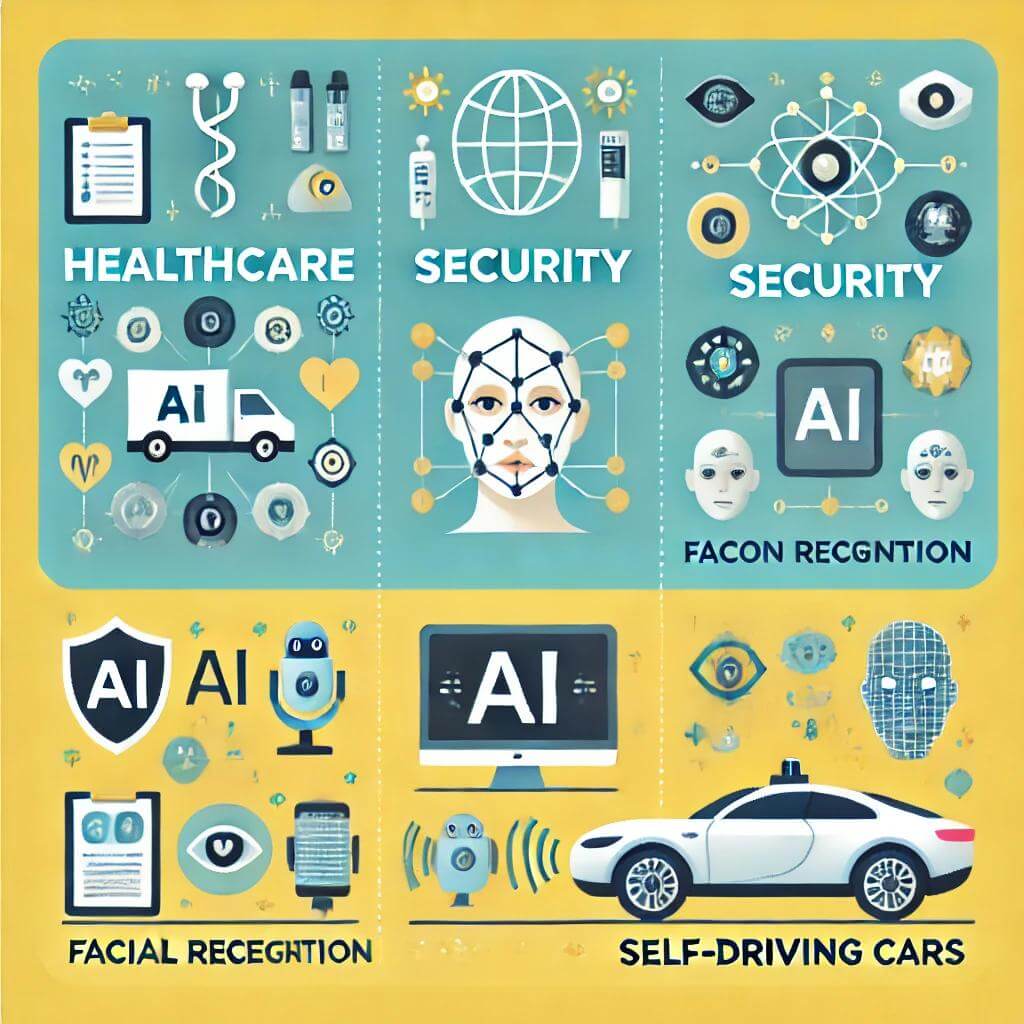AI Applications in Healthcare, Security, and Cars
Technology is advancing at an incredible pace, and one of the most exciting areas is the way AI is applied across various industries. From healthcare to security and autonomous cars, AI-powered solutions are transforming how we live and work. In this article, we’ll explore some of the most impactful applications of AI in these three critical areas.
Healthcare Applications
AI is revolutionizing healthcare, making it possible to diagnose diseases earlier, personalize treatments, and improve overall patient outcomes. Here are a few key areas where AI is making a big impact.
Medical Imaging
One of the most promising uses of AI in healthcare is in medical imaging. AI algorithms are trained to analyze X-rays, MRI scans, and other types of imaging data, helping doctors detect diseases like cancer or cardiovascular problems much earlier than traditional methods.
Example of AI in Medical Imaging
# Example of using AI for tumor detection (pseudo-code)
import tensorflow as tf
from keras.preprocessing import image
model = tf.keras.models.load_model('tumor_detection_model.h5')
img = image.load_img('scan.jpg', target_size=(224, 224))
img_array = image.img_to_array(img)
img_array = img_array/255.0
prediction = model.predict(img_array)
Personalized Medicine
AI is also being used to develop personalized treatments for patients. By analyzing a person’s genetic information, lifestyle, and health data, AI systems can predict the best treatment plans for individual patients.
Virtual Health Assistants
AI-powered virtual assistants help patients manage their conditions, remind them to take medications, and provide guidance on symptoms. These tools reduce the load on healthcare providers while offering patients timely and personalized support.
Security Applications
The role of AI in security is growing rapidly. From detecting potential threats to monitoring large areas in real time, AI is reshaping how security is handled.
Surveillance and Threat Detection
AI can analyze real-time video feeds from surveillance cameras to detect suspicious activities, identify threats, or even recognize faces in crowded areas. This technology is widely used in public spaces like airports, train stations, and stadiums.
Example of AI for Surveillance
# Example of using AI for real-time threat detection (pseudo-code)
import cv2
import tensorflow as tf
# Load trained model for threat detection
model = tf.keras.models.load_model('threat_detection_model.h5')
# Capture video from camera
cap = cv2.VideoCapture(0)
while True:
ret, frame = cap.read()
if not ret:
break
# Process the frame and detect threats
prediction = model.predict(frame)
if prediction == "threat_detected":
print("Alert!")
cv2.imshow("Frame", frame)
cap.release()
cv2.destroyAllWindows()
Facial Recognition for Access Control
In addition to surveillance, facial recognition technology is being used for access control. Businesses and government buildings are implementing AI systems to grant access only to authorized personnel, adding an extra layer of security.
Cybersecurity
AI is also transforming the world of cybersecurity. Machine learning models are used to detect and prevent cyber-attacks in real time by identifying patterns of suspicious behavior in network traffic.
Autonomous Cars
Perhaps the most futuristic and exciting use of AI is in autonomous vehicles. Self-driving cars rely heavily on AI to navigate, detect obstacles, and make real-time decisions to ensure safe travel.
How Autonomous Cars Work
Autonomous cars use a combination of computer vision, machine learning, and sensor fusion to understand their surroundings. The car’s AI system processes data from cameras, radar, and LiDAR sensors to make decisions like when to stop, accelerate, or change lanes.
Object Detection
At the heart of self-driving technology is object detection. Cars must accurately identify pedestrians, other vehicles, road signs, and obstacles. This is typically done using deep learning models such as YOLO (You Only Look Once) or Faster R-CNN.
Example of Object Detection in Autonomous Cars
# Example of using YOLO for object detection in a self-driving car (pseudo-code) import cv2 import numpy as np # Load pre-trained YOLO model net = cv2.dnn.readNet("yolov3.weights", "yolov3.cfg") layer_names = net.getLayerNames() # Load and process the video feed from the car’s camera cap = cv2.VideoCapture("car_feed.mp4") while True: ret, frame = cap.read() if not ret: break # Run object detection blob = cv2.dnn.blobFromImage(frame, 0.00392, (416, 416), swapRB=True, crop=False) net.setInput(blob) outputs = net.forward(layer_names) # Display detected objects for output in outputs: for detection in output: confidence = detection[4] if confidence > 0.5: print("Object Detected") cap.release() cv2.destroyAllWindows()
Advantages of Autonomous Vehicles
- Increased Safety: Autonomous cars can react faster than humans, reducing accidents.
- Efficiency: AI can optimize routes, leading to less traffic congestion and lower fuel consumption.
- Accessibility: Self-driving cars offer mobility solutions for people unable to drive, such as the elderly or disabled.
Conclusion
AI is transforming healthcare, security, and transportation in profound ways. In healthcare, it’s improving diagnostics and personalizing treatments. In security, AI enhances threat detection and access control. Meanwhile, in autonomous vehicles, AI is driving us toward a future where self-driving cars are the norm. As AI technology continues to evolve, its impact on these industries will only grow.



Post Comment